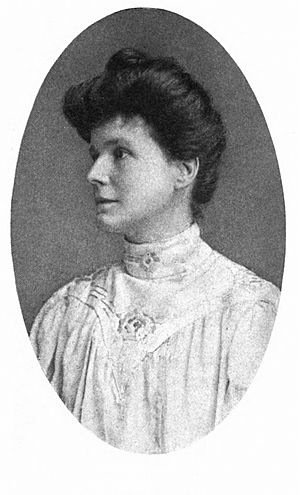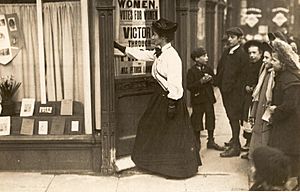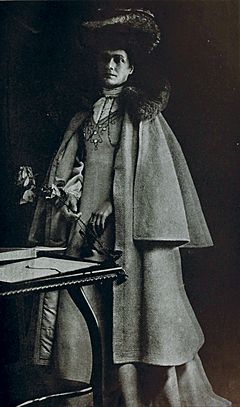May Sinclair facts for kids
Quick facts for kids
May Sinclair
|
|
|---|---|

May Sinclair c. 1912
|
|
| Born | Mary Amelia St. Clair 24 August 1863 Rock Ferry, Cheshire, England, United Kingdom of Great Britain and Ireland |
| Died | 14 November 1946 (aged 83) Buckinghamshire, England, United Kingdom |
| Occupation | Novelist and poet |
| Nationality | British |
May Sinclair was the pen name of Mary Amelia St. Clair (born August 24, 1863 – died November 14, 1946). She was a popular British writer. She wrote many novels, short stories, and poems.
May Sinclair was also a strong supporter of women's right to vote. She was part of the Woman Writers' Suffrage League. She even dressed up as a famous writer, Jane Austen, for a fundraising event. Sinclair was also important in understanding modern writing. She was the first to use the phrase "stream of consciousness" in literature. This phrase describes a writing style that shows a character's thoughts and feelings as they happen. She used it when reviewing a book series called Pilgrimage in 1918.
Contents
Early Life and Education
May Sinclair was born in Rock Ferry, Cheshire, England. Her mother, Amelia Sinclair, was very strict and religious. Her father, William Sinclair, owned ships in Liverpool. He lost all his money and died when May was young.
After her father's death, her family moved to Ilford, near London. May studied for one year at Cheltenham Ladies College. But she had to leave to take care of her older brothers. Four of her five brothers had a serious heart disease.
Writing Career and Activism
From 1896, May Sinclair wrote to earn money for herself and her mother. Her mother passed away in 1901. May was a strong feminist. This means she believed in equal rights for women. She wrote about women's roles and marriage in her books. Her books sold very well in the United States.
May Sinclair's work for women's voting rights was remembered by Sylvia Pankhurst. Photos show her near the offices of the Women's Social & Political Union (WSPU). In 1912, the Women Writers' Suffrage League published her ideas. She believed that women's right to vote and the fight for workers' rights were similar. She felt working women should not compete with working men.
Around 1913, she helped start the Medico-Psychological Clinic in London. This clinic was run by Dr. Jessie Murray. Sinclair became interested in psychoanalysis. This is a way of understanding the human mind and emotions. She included ideas from Sigmund Freud's teachings in her novels.
In 1914, she volunteered to join the Munro Ambulance Corps. This group helped wounded Belgian soldiers during World War I. She went to the Western Front in Flanders. She was sent home after only a few weeks. She wrote about her experiences in both stories and poems.
Famous Works
Her 1913 novel The Combined Maze was very popular. It tells the story of a London office worker and the two women he loves. Famous writers like George Orwell praised it. Agatha Christie thought it was one of the best English novels of its time.
Sinclair also wrote early reviews of a poetry style called Imagism. She wrote about the poet H. D. in 1915. She was friends with H. D., Richard Aldington, and Ezra Pound. She also wrote positive reviews of poems by T. S. Eliot in 1917. And she reviewed the stories of Dorothy Richardson in 1918.
Some of Sinclair's later novels used modern writing styles. Her autobiographical book Mary Olivier: A Life (1919) is an example. She was included in a collection of modern writers in 1925.
Supernatural Stories
May Sinclair wrote two books of supernatural fiction. These are stories about ghosts and strange events. They are called Uncanny Stories (1923) and The Intercessor and Other Stories (1931).
Many critics have praised her supernatural tales. E. F. Bleiler called her an "underrated writer." He said Uncanny Stories was "excellent." Brian Stableford noted that her "supernatural tales are written with uncommon delicacy and precision." He said they are very effective.
Later Life
From the late 1920s, May Sinclair began to show signs of Parkinson's disease. This made it hard for her to write. She stopped writing and moved to Buckinghamshire in 1932. She lived there with a companion.
May Sinclair is buried at St John-at-Hampstead's churchyard in London.
Interests in Philosophy and Psychical Research
Sinclair also wrote non-fiction books about philosophy. She was especially interested in idealism. In her book A Defence of Idealism (1917), she supported a type of idealistic monism. This idea suggests that everything is connected and comes from one basic thing.
May Sinclair was also interested in parapsychology and spiritualism. These fields study things like psychic abilities and communication with spirits. She was a member of the Society for Psychical Research starting in 1914.
Works
- Nakiketas and other poems (1886) as Julian Sinclair
- Essays in Verse (1892)
- Audrey Craven (1897)
- Mr and Mrs Nevill Tyson (1898) also The Tysons
- Two Sides Of A Question (1901)
- The Divine Fire (1904)
- The Helpmate (1907)
- The Judgment of Eve (1907) stories
- The Immortal Moment (1908)
- Kitty Tailleur (1908)
- Outlines of Church History by Rudolph Sohm (1909) translator
- The Creators (1910)
- Miss Tarrant's Temperament (1911) in Harper's Magazine
- The Flaw in the Crystal (1912)
- The Three Brontes (1912)
- Feminism (1912) pamphlet for Women's Suffrage League
- The Combined Maze (1913)
- The Three Sisters (1914)
- The Return of the Prodigal (1914)
- A Journal of Impressions in Belgium (1915)
- The Belfry (1916)
- Tasker Jevons: The Real Story (1916)
- The Tree of Heaven (1917)
- Mary Olivier: A Life (1919)
- The Romantic (1920)
- Mr. Waddington of Wyck (1921)
- Life and Death of Harriett Frean (1922)
- Anne Severn and the Fieldings (1922)
- Uncanny Stories (1923)
- A Cure of Souls (1924)
- The Dark Night: A Novel in Unrhymed Verse (1924)
- Arnold Waterlow (1924)
- The Rector of Wyck (1925)
- Far End (1926)
- The Allinghams (1927)
- History of Anthony Waring (1927)
- Fame (1929)
- Tales Told by Simpson (1930) stories
- The Intercessor, and Other Stories (1931)
- Villa Désirée (1932)
See also
 In Spanish: May Sinclair para niños
In Spanish: May Sinclair para niños



